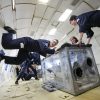2024 Graduate Showcase: “Post-Midwest”
A nexus where artists converge in pursuit of artistic innovation, experimentation, and collaboration
May 17 – July 31, 2024
Columbia, MO The annual Graduate Showcase features work from first and second year MFA candidates will be on view May 17 – July 31, 2024 with a reception on May 17, 5:30 – 7:30pm. Attendees can enjoy refreshments and bring a black T-shirt or tote for on-site screenprints, T’s will be available for purchase as well.
This year’s iteration, “Post-Midwest,” features an international cohort of graduate artists working in painting, printmaking, ceramics, sculpture, new media, and fibers. The exhibit acts in response to the BFA Senior Showcase, “Nascent Spaces”. From the statement: In reflecting on the Midwest identity, the student artists in “Nascent Spaces” look outward to the world beyond the region with a focus on its exoticism, glamor, and [homo]erotic fantasies... The Midwest, for us, is not the center or even, necessarily, “west” of our own geographic reference points. It is simply a landing point in the flyover states—a nexus where we converge in pursuit of our own artistic innovation, experimentation, and collaboration. Here, we begin to imagine what our artistic futures entail, after this brief midwestern interlude. Materially and thematically, we are not all bound to engage with our temporary surroundings in the same way... In imagining new possibilities [of a] “post-Midwest,” we are each attempting to locate the geographic center of our own expressive worlds.” A full statement is included below.
Participating students: Igor Arume, Hanieh Davishan, Rain Embuscado, Summer Hall, Chandler Lemmon, Adekunle Ogunleke, Andrew Long, Emily Smith, William Wallace III.
The Bingham Gallery is an exhibition space and living laboratory for contemporary art practice and interpretation. Central to the interdisciplinary curriculum of the School of Visual Studies, the gallery provides a platform for critical thinking across media, disciplines, cultures, and contexts. Through the exhibition of a diverse array of artwork created by student, emerging, established, and visiting artists, the gallery provides the SVS, university, and local communities with opportunities for direct involvement and exchange with the visual arts; informs and deepens the curriculum taught in the School of Visual Studies; serves as a training ground for students as emerging arts professionals in the arts economy.
Established in 2017, the MU School of Visual Studies merges four disciplines: art, art history, film studies, and digital storytelling. This dynamic program aims to graduate future generations of outstanding critical thinkers, inventive problem solvers, and makers of conscientious, well-crafted art while preparing them for professional careers in the contemporary art world.
###
STATEMENT:
Post-Midwest: Grad Showcase 2024
In dialogue with the BFA show “Nascent Spaces,” in which the real and imagined Midwest features as a “nascent space” for artistic growth, “Post-Midwest” posits a de-centering of the region. The absurdity of the “midwest” as a region is inescapable: the geographic center of the U.S. is in South Dakota, so it is neither the “middle” of the continent nor the “middle” of the western United States. Yet the idea of the “Midwest” automatically conjures an array of stereotypes and aesthetic motifs, addressed in the work of several student artists in the BFA show: an American breadbasket, a place of wholesome abundance entwined with the violence of commercial livestock farming; homes adorned with the sterile nostalgia of vintage, homemade kitsch (“Midwesticana”) and the material embellishment in floral patterned wallpaper, lace, quilts, and calico; notions of childhood growth, family, and faith interrupted by violence and abuse and repression. In reflecting on the Midwest identity, the student artists in “Nascent Spaces” look outward to the world beyond the region with a focus on its exoticism, glamor, and [homo]erotic fantasies.
“Post-Midwest” features an international cohort of graduate artists working in painting, printmaking, ceramics, sculpture, new media, and fibers. Our vantage point is opposite to that of the BFA students: many of us encounter the region as newcomers and outsiders, carrying with us the cultural and creative influences of our own homelands. The Midwest, for us, is not the center or even, necessarily, “west” of our own geographic reference points. It is simply a landing point in the flyover states—a nexus where we converge in pursuit of our own artistic innovation, experimentation, and collaboration. Here, we begin to imagine what our artistic futures entail, after this brief midwestern interlude. Materially and thematically, we are not all bound to engage with our temporary surroundings in the same way. We delve into this new landscape while also mining the complex strata of our public and personal archives—the things we discover around us, under the surface, and the things we have carried here as baggage. “Midwest” —and specifically, MU—functions as an ecotone, a place of diversity at the convergence of different ecosystems and experiences, where we can encounter both the feral and the cultured, where our creative synapses respond to the paradoxes of the place and the potential of ourselves as we are inspired by one another. In imagining new possibilities “post-Midwest,” we are each attempting to locate the geographic center of our own expressive worlds.







